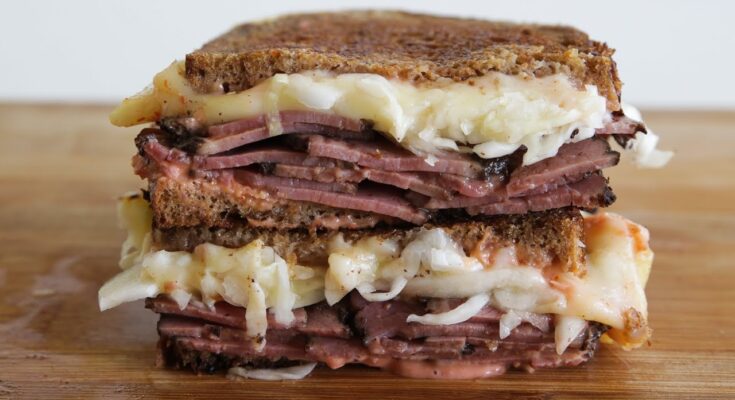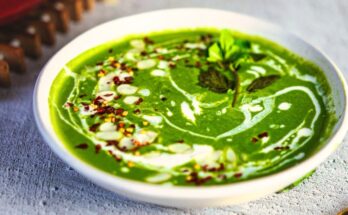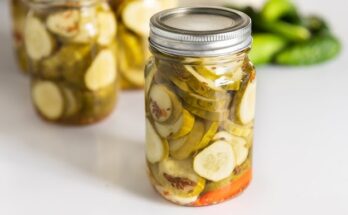Pastrami Sandwich Recipe: There’s something incredibly satisfying about biting into a pastrami sandwich. The smoky, peppery layers of meat nestled between slices of bread are a treat for the taste buds. What sets it apart from other sandwiches? It’s that perfect harmony of spice, texture, and heartiness that only pastrami can bring. Unlike plain deli meats, pastrami is brined, seasoned, smoked, and steamed, giving it a robust flavor profile that hits all the right notes. It’s a sandwich that doesn’t just feed you—it speaks to your soul.
Whether you’re grabbing one from a New York deli or making it at home, a well-made pastrami sandwich is both comfort food and a culinary experience. It’s got layers of complexity but comes together with minimal effort, making it ideal for both lunch breaks and lazy Sunday brunches.
A Brief History of Pastrami
Pastrami has roots tracing back to Eastern Europe, where it was traditionally made from goose or duck. Romanian immigrants brought the concept to America in the late 19th century. Once in New York, beef brisket took over as the go-to cut, and pastrami as we know it was born. Thanks to Jewish delis like Katz’s in NYC, pastrami sandwiches became a staple of American comfort cuisine.
Ingredients You’ll Need
Essential Ingredients for the Classic Pastrami Sandwich
Before diving into the process, let’s gather everything you’ll need. Here’s a list of must-haves for the classic pastrami sandwich:
- Pastrami: Ideally, you’ll want about 6-8 oz. of thinly sliced pastrami per sandwich.
- Rye Bread: The traditional base—sturdy, flavorful, and with just the right amount of chew.
- Swiss Cheese: Adds a creamy, nutty flavor that balances the spice of pastrami.
- Deli Mustard: A sharp, tangy mustard is the go-to condiment.
- Butter: For toasting the bread to golden perfection.
- Pickles: Crunchy, tangy pickles are the ultimate sidekick.
These basic ingredients make up the core of the classic sandwich. The magic, however, lies in how you assemble and serve them.
Optional Add-ons to Boost Flavor
Want to take things up a notch? Here are a few optional additions that can enhance your pastrami sandwich:
- Sauerkraut: Especially great in a Reuben-style version.
- Russian Dressing: A tangy, creamy option if mustard isn’t your thing.
- Onions (caramelized or raw): For added sweetness or crunch.
- Tomatoes and Lettuce: If you prefer a fresher twist.
- Spicy Peppers or Relish: To add a bit of heat or tang.
Feel free to mix and match based on your preferences. The beauty of the pastrami sandwich is its versatility.
Choosing the Right Bread
Why Rye Bread Is the Traditional Favorite
If you’ve ever walked into a Jewish deli and ordered a pastrami sandwich, chances are it was served on rye bread. Why? Because rye is bold enough to hold its own against the strong flavors of pastrami. Its slightly sour note and dense texture complement the meat rather than overshadowing it. Classic Jewish rye also includes caraway seeds, which add an extra layer of aromatic complexity.
Rye doesn’t fall apart under the weight of warm meat and melted cheese. It’s structurally sound and flavor-forward, making it the best foundation for a sandwich that means business.
Alternative Breads for a Twist
Not a fan of rye? That’s okay. While purists may raise an eyebrow, there’s room for creativity. Here are some worthy alternatives:
- Sourdough: Offers a tangy depth and sturdy build.
- Ciabatta: Light and airy with a chewy crust.
- Multigrain: For a nutty flavor and extra fiber.
- Brioche or Challah: If you want something softer and slightly sweet.
- Kaiser Roll: Great for a deli-style, handheld sandwich.
Just remember—whatever bread you choose should be able to stand up to the heat and juices of the pastrami without turning soggy.
Step-by-Step Preparation Guide
Step 1: Prepping Your Ingredients
Start by laying everything out. Make sure your pastrami is thinly sliced, your cheese is ready, and your condiments are within reach. Preheat a skillet or griddle to medium heat—it’ll help later with toasting and melting the cheese.
If you’re using pickles, slice them ahead of time. Want to add caramelized onions or sautéed peppers? Cook those in advance so assembly goes smoothly.
Step 2: Toasting the Bread
Butter one side of each slice of bread. Place them butter-side down on the hot skillet. Toast until golden brown, which usually takes 2-3 minutes. Flip if you prefer both sides toasted, but traditionally, only the outside is crisped while the inside stays soft.
Step 3: Heating the Pastrami
Place the sliced pastrami in the skillet or microwave just until it’s warm. You don’t want it overcooked or dry—just heated through. Some people like to steam it slightly for a moist, deli-style texture. To do this, place it in a pan with a splash of water and cover until warmed.
Step 4: Assembling the Sandwich
Now comes the fun part. Lay the toasted bread flat. On one side, spread mustard. Layer on the pastrami, pile it high, then add cheese. If you’re using extras like pickles or onions, layer them on top. Close it with the other slice of bread.
For a meltier experience, press the sandwich in a panini press or back on the skillet for a minute or two.
Step 5: Serving and Slicing
Use a sharp knife to slice the sandwich in half—diagonally for presentation points. Serve with a side of dill pickles or coleslaw. A handful of chips doesn’t hurt either. Enjoy it hot for the best flavor.
Tips for the Perfect Pastrami Sandwich
Best Cheese Pairings
While Swiss cheese is the classic choice for a pastrami sandwich, there are other cheeses that can elevate your sandwich experience. Each cheese brings a unique flavor and texture that can complement or contrast the smoky richness of the pastrami.
- Swiss Cheese: Mild and nutty, it melts beautifully without overpowering the pastrami.
- Provolone: Creamy and smooth with a slight sharpness, it’s a great substitute for Swiss.
- Cheddar: For those who like a little bite, sharp cheddar adds a robust kick.
- Muenster: Mild and melty, it blends well with spicy condiments.
- Pepper Jack: Adds a spicy twist for heat lovers.
Cheese should always be thinly sliced or shredded for even melting. Place it directly over the warm pastrami to ensure it softens perfectly.
Mustard or Mayo – The Great Debate
This is a debate that’s split pastrami fans down the middle. Traditionalists will argue that spicy deli mustard is the only way to go. It cuts through the fattiness of the meat and enhances its bold flavor. Others prefer the creamy tang of mayonnaise, which smooths out the sharp spices.
Want the best of both worlds? Try combining the two for a creamy, tangy spread. Alternatively, Russian or Thousand Island dressing is a popular choice, especially in a Reuben-style sandwich.
Ultimately, the choice depends on your taste buds. There’s no wrong answer here—just tasty options.
Toast or No Toast?
To toast or not to toast—that is the question. Toasting your bread adds a satisfying crunch and helps prevent sogginess, especially if your sandwich includes moist ingredients like pickles or sauerkraut.
Here’s a quick breakdown:
Toast it if:
- You’re adding cheese and want it melted.
- You like a crisp texture contrast.
- You’re serving immediately and want it warm.
Skip toasting if:
- You prefer a softer bite.
- You’re packing the sandwich for later.
- You want the traditional deli-style “soft” rye feel.
If you do toast, a quick butter or mayo spread on the outside before hitting the pan adds a beautiful golden finish.
Variations of the Pastrami Sandwich
New York Deli-Style Pastrami Sandwich
This is the iconic version everyone thinks of—served high and proud on rye bread with mustard and nothing else. The focus here is the meat. Piled several inches thick, it’s all about savoring the flavor of perfectly seasoned, smoked pastrami.
How to Make It:
- Use freshly sliced pastrami (8–10 oz).
- Choose seeded Jewish rye.
- Spread deli mustard generously.
- No cheese, no extras—just meat, mustard, and bread.
Pastrami Reuben Sandwich
This variation swaps out the usual corned beef for pastrami in a classic Reuben. It’s messy, gooey, and utterly delicious.
Ingredients:
- Pastrami
- Swiss cheese
- Sauerkraut
- Russian or Thousand Island dressing
- Rye bread (buttered and toasted)
Assemble like a grilled cheese—start with the bread, layer everything in between, and grill until golden and melty.
Pastrami Club Sandwich
For something a bit different, the pastrami club adds extra layers and ingredients, usually served on toasted white or multigrain bread.
Ingredients:
- Pastrami
- Bacon
- Lettuce
- Tomato
- Mayo
- Triple-decker bread
Stacked like a club sandwich, it’s ideal for hearty appetites and makes a great lunch option when you’re craving variety.
Nutrition Facts
While not exactly diet food, a pastrami sandwich can still be enjoyed in moderation. The nutritional content varies based on ingredients and portion size, but here’s a general breakdown for a standard pastrami sandwich:
| Component | Approximate Amount |
|---|---|
| Calories | 550–700 kcal |
| Protein | 30–40g |
| Fat | 30–40g |
| Carbohydrates | 35–45g |
| Sodium | 1200–1500mg |
To make it healthier:
- Use whole grain or lower-carb bread.
- Opt for low-fat cheese or skip it.
- Load up on fresh veggies.
- Use mustard instead of mayo or creamy dressings.
Moderation is key. One pastrami sandwich every now and then won’t derail your diet, especially if you balance it with lighter meals.
FAQs about Pastrami Sandwich Recipe
Can I make pastrami at home?
Yes! While it’s a bit of a process, making pastrami at home is totally doable. You’ll need a beef brisket, a curing brine, a spice rub (typically coriander, black pepper, garlic, and paprika), and a smoker or oven for the final steps. The whole process takes several days but yields delicious, authentic results.
What’s the best store-bought pastrami?
For convenience, many delis and grocery stores carry great pastrami. Brands like Boar’s Head and Dietz & Watson offer deli-style cuts that are flavorful and easy to use. If you’re near a Jewish deli or a butcher that smokes in-house, always go for the freshly sliced option for the best texture and flavor.
How do I store leftover pastrami?
Leftover pastrami should be wrapped tightly in foil or stored in an airtight container in the fridge. It will keep for about 4-5 days. For best results, reheat gently in a skillet or steamer to retain its tenderness and flavor.
Can I freeze pastrami?
Absolutely. To freeze pastrami, wrap it tightly in plastic wrap and foil or place it in a zip-top freezer bag. It can last for up to 2 months. When ready to use, thaw in the fridge overnight and reheat gently.
What drink pairs well with a pastrami sandwich?
A cold, crisp beer—especially a lager or pilsner—pairs wonderfully with pastrami. If you’re skipping alcohol, go for a tangy lemonade or a classic deli soda like Dr. Brown’s Black Cherry. Iced tea and root beer also complement the bold flavors nicely.
Conclusion
So next time you’re hungry and want something that hits all the right spots—smoky, savory, tangy, crunchy—remember this guide. Gather your ingredients, toast that bread, and build yourself a sandwich that would make any deli proud.
And hey, once you’ve mastered it, don’t keep it to yourself. Share it with friends, pack it for a picnic, or post your own twist on social media. Pastrami sandwiches are meant to be enjoyed and celebrated. Happy eating!



